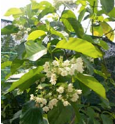Kerak Nasi
| Kerak Nasi | |
| Nama Saintific | Vallaris glabra Ktze |
| Common Name | Bread Flower (Englisa); Kesidang , Kerak Nasi (Malay) |
| Synonyms | Canangrium scortechinii /Sambucus javanica Reinw /Vallaris pergulana @ pergularia @ glabra@ indecora @s olanacea, Pergularia glabra L |
| Order | Gentiananae |
| Family | Apocynaceae |
| Plant Material of Interest | White flowers that emit a strong pandan fragrance |
 |
{slider= General Appearance}
Woody climber with broadly elliptic leves of 7-9x 4-6cm in size (Wongpornchai et al 2003). Inflorescences are long-stalked with clusters of fragrant cup-like white flowers of 1–1.5 cm in diameter. The plant is well known in Thailand because its flowers have a scent of leaves of pandan or newly cooked fragrant rice.
{/slider}
{slider=Geographical & Distribution}
Originated from Java in Indonesia, the species grows in full sun and can be propagated by marcotting (Ng, 2006). It is native in India & Burma and also found in Sylhlet in Bangladesh (Karmakar UK et al 2011)
{/slider}
{slider=Chemical Constituents}
Phytochemical screening of extract of V. glabra showed the presence of terpenoids, tannins and saponins ( Wong SK et al 2011).
The aromatic compound with a strong fragrance is 2-acetyl-1-pyrroline (Wongpornchai et al, 2003)
The plants contents a mixture of glycosides vallarisoside and a known one, 3β-O-(α-acofriosyl) along with a new glycoside, benzyl 2-O-β-apiofuranosyl-(1-2)-β- D-glucopyranosyl-2 (Ahmed et al 2010) and 0-acetyl-solanoside (0-acetyl-acofreosyl digitoxigenin (Vohra et al 1966). Fresh flowers have 50 volatile components
{/slider}
{slider=Traditional Uses}
It is traditionally used for sores and wounds. Barks are chewed for fixing teeth (Vohra et al 1966)
{/slider}
{slider=Pharmacology}
Analgesic Activities
Ethanolic extractof leaves and stem showed significant analgesic activity (p<0.005) in acetic acid induced writhing inhibition in mice at the dose of 500mg/kg body weight and also showed mild effect at the doses of 250mg/kg b.w. (Karmakar UK et al 2011), cytotoxicity activity (Rifai Y et al 2011).
Antiproliferative
Methanol extract of V. glabra showed strong antiproliferative activity against all six human cancer cell lines tested (MCF-7, MDA-MB-231, HeLa, HT-29, SK0V-3 and HepG2). V. glabra suggested that potentially safe for use to treat malaria (Wong SK et al 2011). Leaf extract V. glabra displayed positive antiproliferative activity. V. glabra methanolic extract decrease the ulcer index significantly compared to the positive control group (Ranitidine 30mg/kg) in mode pylorus ligation and ethanol induced gastric ulcer in rats and 3.2mg/kg and 6.4 mg/kg doses. In models pylorus ligation V. glabra methanolic extrac decreased the volume of gastric juice, pH, total and free acidity. The extracts also shown significant antioxidant by reduces the lipid peroxidation and increase the catalase activity (Das S.K., et al 2013)
{/slider}
{slider=References}
Das S.K., Pansuriya P.V., S.T. Shukla, K.J. Gohil, S.P. Roy, A. Choudhury, V.N. Sutariya (2013). Preclinical evaluation of Vallaris solanacea (roth) Kuntze stem for its antiulcer and antioxidant activity in wistar albino rats Orient Pharm Exp Med. DOI 10.1007/s13596-013-0133-3.
Karmakar U.K., D. Ghosh & S.K. Sadhu (2011). Assessment of Analgesic, Cytotoxic and Antioxidant activitites of Vallaris solanacea (Roth) Kuntze. Stamford Journal of Pharmaceutical Sciences 4(1):64-68.
Wong S.K., Lim YY., Abdullah NR & Nordin F.J.(2011) Assessment of antiprolifertive and plasmodial activities of five selected Apocynaceae species. BMC Complemetary & Alternative Medicine.,11(3);1-8.
(http://www.ncbi.nlm.nih.gov/pmc/articles/PMC3032759/)
Wongpornchai, S., Sriseadka, T., Choonvisase, S. (2003). dentification and quantitation of the rice aroma compound, 2-acetyl-1-pyrroline, in bread flowers (Vallaris glabra Ktze)”. Journal of Agricultural and Food Chemistry 51: 457–462. DOI: 10.1021/jf025856x.
Ng, F.S.P. (2006). “Tropical Horticulture and Gardening”. Clearwater Publications, Kuala Lumpur, Malaysia, 361 p., ISBN: 983-42954-0-5.
Vohra, M.M.; Patnaik, G.K.; Kapil, R.S.; Anad,N. (1966).”Chemistry and pharmacology of a glycoside of Vallaris solanacea. Journal of Pharmaceutical Science, Vol 55(12, Pg 1452-1428.
{/slider}
- Last updated on .
- Hits: 2621
